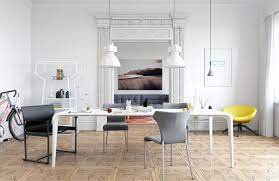Introduction
Scandinavian design is known for its simplicity, functionality, and beauty. Inspired by the natural landscapes of the Nordic region, Scandinavian interiors often feature clean lines, neutral colors, and an emphasis on light and space. In this article, we’ll explore the key elements of Scandinavian-inspired dining room design and how to create a space that is both inviting and stylish.
Characteristics of Scandinavian Design
Scandinavian design is characterized by several key principles that contribute to its timeless appeal.
Simplicity and Minimalism
At the heart of Scandinavian design is a commitment to simplicity and minimalism. Spaces are free from clutter and unnecessary ornamentation, allowing the beauty of the design to shine through.
Natural Materials
Scandinavian interiors often feature natural materials such as wood, stone, and leather. These materials add warmth and texture to the space while connecting it to the natural world outside.
Light and Airy Spaces
Light plays a crucial role in Scandinavian design, with large windows and open floor plans maximizing natural light and creating an airy atmosphere. White walls and light-colored floors further enhance the sense of brightness and space.
Color Palette and Textures
The color palette and textures used in a Scandinavian-inspired dining room are key to creating the right look and feel.
Neutral Colors
Neutral colors such as white, beige, and gray form the foundation of Scandinavian design, providing a clean and calming backdrop for the space. These colors also help to reflect light and create a sense of openness.
Warm Wood Tones
Warm wood tones are a hallmark of Scandinavian design, adding warmth and character to the space. Opt for light or medium-toned woods such as oak, birch, or pine for furniture, flooring, and accessories.
Textural Contrast
Incorporate a mix of textures such as wool, fur, and linen to add visual interest and coziness to the dining room. Consider layering rugs, throws, and cushions to create a sense of warmth and comfort.
Furniture and Decor
When selecting furniture and decor for a Scandinavian-inspired dining room, focus on functionality and simplicity.
Functional and Streamlined
Choose furniture pieces that are both stylish and practical, with clean lines and simple silhouettes. Look for pieces with built-in storage solutions to maximize space and minimize clutter.
Iconic Scandinavian Pieces
Consider incorporating iconic Scandinavian furniture pieces such as the Wishbone chair, Eames chair, or Panton chair to add a touch of timeless elegance to the dining room.
Cozy Textiles and Accessories
Soft textiles such as sheepskin throws, woolen blankets, and linen napkins add warmth and texture to the dining room, while minimalist tableware and accessories keep the space looking clean and uncluttered.
Lighting
Lighting plays a crucial role in creating the right ambiance in a Scandinavian-inspired dining room.
Natural Light
Maximize natural light by keeping windows unobstructed and using light-colored window treatments. Consider adding skylights or light tubes to bring in even more natural light during the day.
Modern Lighting Fixtures
Choose modern lighting fixtures such as pendant lights, chandeliers, or wall sconces to illuminate the dining area and add a touch of contemporary style.
Candles and Ambient Lighting
Create a cozy atmosphere in the dining room with candles and ambient lighting. Place candles on the dining table or around the room to add warmth and intimacy to the space, especially during evening meals.
Plants and Greenery
Bringing nature indoors is an essential aspect of Scandinavian design.
Bringing the Outdoors In
Incorporate plants and greenery into the dining room to create a sense of freshness and vitality. Choose low-maintenance plants such as succulents, ferns, or snake plants that thrive indoors with minimal care.
Planters and Vessels
Display plants in stylish planters or vessels that complement the overall aesthetic of the dining room. Consider hanging planters from the ceiling or placing potted plants on shelves or sideboards to add greenery at different heights.
Creating a Focal Point
Create a focal point in the dining room to draw the eye and anchor the space.
Statement Furniture or Artwork
Choose a statement piece of furniture or artwork to serve as the focal point of the dining room. This could be a sculptural dining table, a striking piece of artwork, or a bold light fixture that becomes the centerpiece of the room.
Fireplace or Accent Wall
If your dining room has a fireplace or an accent wall, use it to create visual interest and depth. Paint the accent wall in a contrasting color or add texture with wallpaper to make it stand out.
Eye-Catching Light Fixture
A unique and eye-catching light fixture can instantly elevate the look of the dining room and become a conversation piece. Choose a modern chandelier or pendant light that complements the overall style of the space.
Practical Considerations
In addition to aesthetics, consider practical aspects such as storage, durability, and comfort when designing your Scandinavian-inspired dining room.
Storage Solutions
Incorporate built-in storage solutions such as cabinets, sideboards, or shelving units to keep dining essentials organized and out of sight. Choose pieces with clean lines and minimal hardware to maintain the sleek look of the space.
Durability and Easy Maintenance
Opt for durable materials and finishes that can withstand daily use and are easy to clean and maintain. Look for stain-resistant fabrics, scratch-resistant surfaces, and finishes that are resistant to moisture and heat.
Comfortable Seating
Choose comfortable seating options such as upholstered dining chairs or bench seating with plush cushions to encourage lingering meals and lively conversations. Consider adding seat cushions or chair pads for extra comfort during longer gatherings.
Conclusion
Designing a Scandinavian-inspired dining room is all about creating a space that is both beautiful and functional. By incorporating key elements such as natural materials, neutral colors, and cozy textiles, you can create a dining room that exudes warmth, comfort, and timeless style.
